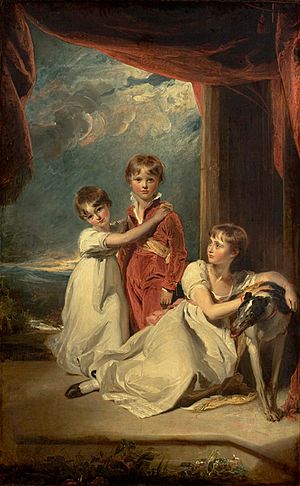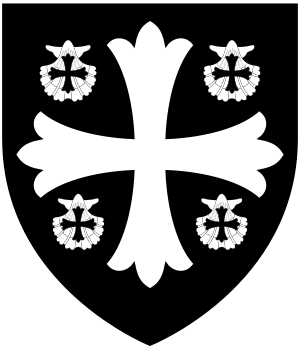Sir Samuel Fludyer, 3rd Baronet facts for kids

Sir Samuel Fludyer, 3rd Baronet (born in 1800, died in 1876) was a very interesting person from a wealthy family. He was the grandson of the first Sir Samuel Fludyer, who was known as one of the richest men in England when he passed away. He had a huge fortune of about £900,000!
Sir Samuel was the only son of Sir Samuel Brudenell Fludyer, who was the 2nd Baronet. His family was so rich that they had their children's portraits painted by Thomas Lawrence. Lawrence was a famous artist at that time. This painting shows how important and wealthy the family was. In the picture, you can see young Sir Samuel (who would become the 3rd Baronet) standing between his two sisters, Maria and Carolina Louisa.
Sir Samuel went to Christ Church, Oxford for his education. In 1833, he became the 3rd Baronet after his father passed away. Sadly, after a disagreement with his sisters, Sir Samuel was sent to a private mental health hospital called Ticehurst Private Asylum in Sussex in 1839. He stayed there for the rest of his life.
Family Fortune and Inheritance
Sir Samuel was admitted to the asylum by doctors and his brother-in-law. Because he was in the asylum, he never married or had children. When he passed away, his large fortune was divided between his two sisters, Maria Fludyer and Caroline Louisa Derby.
His father's will had a special rule. If Samuel died without children, most of his money and the Baronet title would go to his uncle, George Fludyer, and his male heirs. However, Samuel was allowed to decide what happened to £80,000 of his own money. In the end, his sisters inherited this entire £80,000, sharing it equally.
The asylum where Sir Samuel stayed also benefited from his family's wealth. He was one of their highest-paying patients in the 1840s, costing 12 guineas each week. This was a lot of money back then!
Changes in Mental Health Laws
Sir Samuel's situation was one of several cases from Ticehurst Asylum that caught the attention of a group called the Lunacy Law Reform Committee. This committee was started in 1873. They worked to improve the laws about mental health care.
A woman named Louisa Lowe, who used to work for a similar group, wrote a book in 1883. It was called "The Bastilles of England." In her book, she talked about cases like Sir Samuel's to show problems with private mental health hospitals.
The old laws that allowed people like Sir Samuel to be sent to asylums were later changed. A new law, called the Lunacy Act 1890, was put in place to make things fairer and better for people needing mental health care.
See also
- Fludyer baronets


